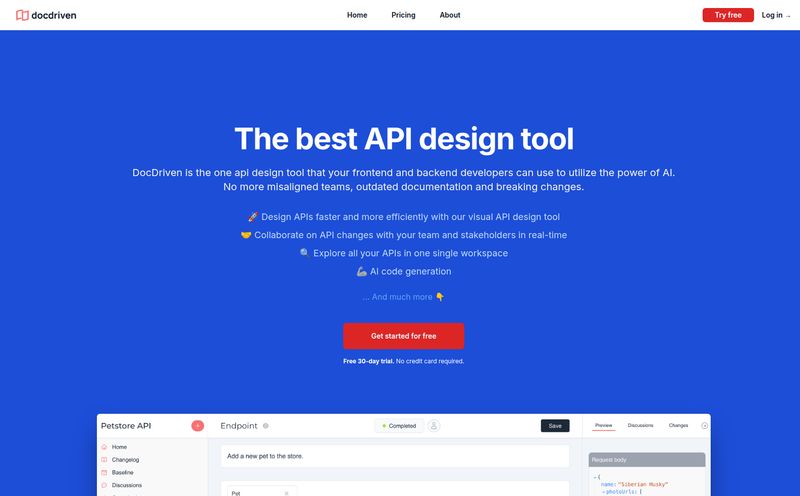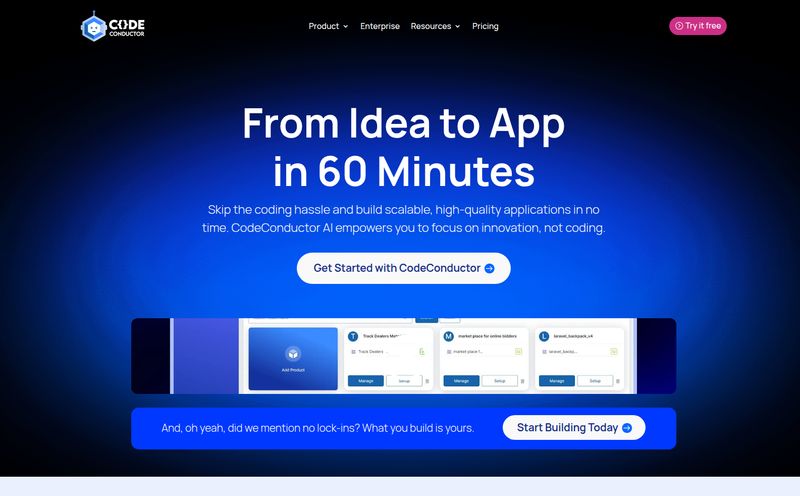You and me. If you’re a developer, you’ve been there. That sinking feeling. You’ve just pushed a brilliant new feature, the code is clean, the UI is slick. You merge the PR, and then it hits you. The translation files. Oh god, the translation files.
Suddenly you’re playing a frantic game of translation whack-a-mole. Copying keys, pasting values into a dozen different JSON files, praying you didn’t miss a placeholder or introduce a syntax error in the Portuguese (Brazil) file. It's a soul-crushing, error-prone process that feels like it was designed by someone who hates joy. For years, I've seen amazing teams get bogged down by this. It’s not just a coding problem; it’s a workflow killer and a major block to reaching a global audience—something I care a lot about in the SEO world.
So when I heard about a tool called LocaleBadger, my ears perked up. It promised to automate this whole messy business on GitHub. Could it be? The end of i18n drudgery? I had to find out.
What Exactly Is LocaleBadger Anyway?
Let's get the jargon out of the way. LocaleBadger is an automation tool for software internationalization (i18n). But that's a boring way of putting it.
Think of it like this: LocaleBadger is a tiny, hyper-focused robot that lives in your GitHub repository. Its only job is to watch for changes in your main language file (say, `en.json`). The moment you add a new line of text for a button, a title, or a tooltip, this little badger wakes up. It automatically translates that new text into all the other languages you’ve configured—Spanish, German, Japanese, you name it—and then, this is the best part, it creates a new pull request with all the updated translation files.
No more manual copy-pasting. No more forgetting to update a file. It’s designed to slot right into your existing Git workflow, especially if you're working with modern frameworks like Gatsby or React. It’s a simple premise, but the implications for your sanity are massive.

Visit LocaleBadger
How This Little Tool Changes Your Daily Grind
The real magic isn't just what it does, but how it changes the way you work. It smooths out one of the biggest bumps in the development road. I’ve always felt that the best tools are the ones that disappear into your workflow, and LocaleBadger comes pretty darn close.
The Sheer Joy of Automated Pull Requests
This is the core feature and, honestly, the main selling point. The process is beautiful in its simplicity. You, the developer, just focus on building things in your primary language. You push your code. A few moments later, a PR from LocaleBadger appears, titled something like "[LocaleBadger] Translations for branch feature-new-dashboard". You can quickly scan the changes, see the machine translations, and if it all looks good, you merge it. Done. The task that used to take 20 minutes (or more) of painstaking, boring work now takes about 20 seconds of review.
Finally, Everything Stays in Sync
The second-biggest headache of i18n is drift. The English version of your app gets three new features, but the German one is still two weeks behind because someone forgot to update the files. It looks unprofessional and erodes user trust. LocaleBadger pretty much eliminates this. Because it triggers on every pull request, your translation files are always in lockstep with your source code. It provides a single source of truth, and that kind of consistency is priceless for both your team and your international users.
The Good, The Bad, and The YAML File
No tool is perfect, of course. It's always a series of trade-offs. So let's get real about what works wonderfully and what you need to be aware of before you jump in.
The Good Stuff (Why I'm Genuinely Impressed)
The most obvious win is the massive amount of time saved. Think about it. If you save even 15 minutes of i18n work per feature, and you ship several features a week, that adds up to hours saved every month. Hours you can spend on more important problems.
Next up is the reduction in human error. I once spent a solid hour debugging a production app because a tired developer had missed a closing quote in a Spanish JSON file. An entire section of the app was just... gone. LocaleBadger, being a robot, doesn't get tired. It doesn’t make typos. It just generates clean, valid files every single time.
And from my SEO perspective, this is huge: it helps you actually achieve global reach. So many companies want to go global, but the friction of localization holds them back. By making it easy, LocaleBadger encourages you to add more languages, which in turn can open up new markets, increase organic traffic from those regions, and build incredible trust with users who see your product in their native tongue.
The Quirks (Things to Keep in Mind)
Okay, so it's not all rainbows and unicorns. First, the setup requires a YAML configuration file. For most devs this is hardly a roadblock, but it's an initial step you have to take. You need to tell it where your source file is, what your target languages are, etc. It's a one-time thing, but it's there.
Second, if you bring your own API key, it's dependent on the Google Cloud Translate API. This means the quality of your initial translations is only as good as Google's machine translation. Let's be honest, it's gotten very good, but it's not a native speaker. The ideal workflow, in my opinion, is to let LocaleBadger do the heavy lifting and then have a native speaker quickly review the generated PR for nuance and accuracy. The tool handles the 90% of grunt work, your team handles the 10% of polish.
Let's Talk Money: The Price of Sanity
This is often the sticking point, isn't it? Well, right now, LocaleBadger is running an interesting offer that caught my eye. They have an early-bird deal for $49 USD. And that’s not per month. That's for lifetime access.
| Plan | Price | Details |
|---|---|---|
| Early-Bird Lifetime | $49 USD | One-time payment. The price is set to increase to $79 soon. Includes a 14-day money-back guarantee. |
Honestly, this feels like a steal. For less than the cost of a nice dinner, you can potentially eliminate one of the most annoying tasks in web development forever. When you calculate the cost of your developers' time, a $49 one-time purchase pays for itself in the first week, maybe even the first day. The fact that it will go up to $79 soon adds a bit of urgency, but even at that price, the value proposition is strong. The money-back guarantee also makes it a pretty risk-free decision.
So, Is LocaleBadger Right for You?
I see this being a perfect fit for a few groups:
- Solo Developers & Freelancers: You wear all the hats. Anything that saves you time is pure gold. This is a no-brainer.
- Small to Medium-Sized Teams: If you're agile and moving fast, this removes a significant bottleneck from your workflow, letting you ship faster.
- React & Gatsby Projects: The tool is clearly built with the modern JavaScript ecosystem in mind, making it a natural fit for these types of projects hosted on GitHub.
Who might want to pause? Huge enterprise companies that already have complex, custom-built, and deeply entrenched localization platforms might find this too simple for their needs. Or if your project isn't on GitHub, well, then this isn't for you.
My Final Verdict on This Translation Tamer
I'm genuinely enthusiastic about LocaleBadger. It's a tool that knows exactly what problem it’s trying to solve, and it solves it with elegance. It’s not trying to be a massive, all-encompassing platform. It does one thing—automating translation file management in GitHub—and it does it exceptionally well.
It turns a tedious, error-prone chore into a seamless, automated background task. For any team that's serious about internationalization but tired of the manual overhead, LocaleBadger isn't just a nice-to-have. It’s a powerful ally in the quest to build better software for a global audience.
Frequently Asked Questions
- 1. Does LocaleBadger work with frameworks other than React and Gatsby?
- Yes! While it's a great fit for them, it's framework-agnostic. As long as you use JSON files for your translations and your repository is on GitHub, it should work just fine.
- 2. Are the automatic translations 100% perfect?
- The translations are generated using the Google Cloud Translate API, which is very accurate for a machine but not a substitute for a native speaker's review. The best practice is to use LocaleBadger's output as a high-quality first draft that a human can then quickly polish for contextual nuance.
- 3. What if I don't want to use my own Google Cloud Translate API key?
- The documentation suggests a "Bring Your Own Key" model, which gives you control. It's likely their service will handle translations for you up to a certain limit as part of the package, but using your own key is often better for high-volume projects. It's best to check their official site for the most current details on this.
- 4. Is the $49 lifetime deal really for life?
- According to their offer, yes. It's an early-bird deal for lifetime access to the tool. These kinds of deals are common for new products to build an initial user base, and they're usually honored for those who get in early.
- 5. How difficult is the YAML configuration?
- If you've ever configured a GitHub Action or a similar CI/CD tool, you'll feel right at home. The config file is straightforward, requiring you to specify paths to your language files and list your target languages. They'll almost certainly have a documentation guide to walk you through it.
Reference and Sources
- i18next Framework - A popular internationalization framework for JavaScript.
- Google Cloud Translation API - The underlying technology for the machine translation.
- W3C Introduction to Internationalization - For more on the principles behind i18n.



